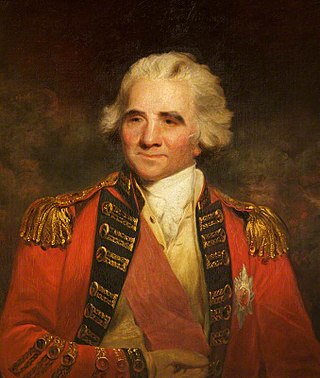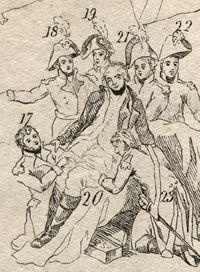
Marquess of Aberdeen and Temair, in the County of Aberdeen, in the County of Meath and in the County of Argyll, is a title in the Peerage of the United Kingdom. It was created on 4 January 1916 for John Hamilton-Gordon, 7th Earl of Aberdeen.

Lieutenant General Sir Ralph Abercromby was a British soldier and politician. He rose to the rank of lieutenant-general in the British Army, was appointed Governor of Trinidad, served as Commander-in-Chief, Ireland, and was noted for his services during the French Revolutionary Wars, ultimately in the Egyptian campaign. His strategies are ranked amongst the most daring and brilliant exploits of the British army.

Baron Audley is a title in the Peerage of England first created in 1313, by writ to the Parliament of England, for Sir Nicholas Audley of Heighley Castle, a member of the Anglo-Norman Audley family of Staffordshire.

Earl of Rosslyn is a title in the Peerage of the United Kingdom. It was created in 1801 for Alexander Wedderburn, 1st Baron Loughborough, Lord Chancellor from 1793 to 1801, with special remainder to his nephew Sir James St Clair-Erskine, as Wedderburn had no surviving issue of his own. Wedderburn had already been created Baron Loughborough, of Loughborough in the County of Leicester, in the Peerage of Great Britain in 1780, with normal remainder to the heirs male of his body, and Baron Loughborough, of Loughborough in the County of Surrey, in the Peerage of Great Britain in 1795, with the same remainder as the earldom. The 1780 barony became extinct upon his death, but the 1795 barony and the earldom passed, by the special remainder, to his nephew, who thus became the second Earl of Rosslyn. The second Earl was a Lieutenant-General in the Army and also held political office as Lord Privy Seal and Lord President of the Council.

Baron Abinger, of Abinger in the County of Surrey and of the City of Norwich, is a title in the Peerage of the United Kingdom. It was created on 12 January 1835 for the prominent lawyer and politician Sir James Scarlett, the Lord Chief Baron of the Exchequer. Lord Abinger was succeeded by his eldest son, the second Baron. He represented Norwich and Horsham in the House of Commons. He was succeeded by his son, the third Baron. He was a lieutenant-general in the army and fought in the Crimean War. On the death of his son, the fourth Baron, the line of the eldest son of the first Baron failed. The late Baron was succeeded by his second cousin, the fifth Baron. He was the grandson of Peter Campbell Scarlett, third son of the first Baron. When he died the title passed to his younger brother, the sixth Baron, and then to another brother, the seventh Baron. As of 2016 the title is held by the latter's grandson, the ninth Baron, who succeeded his father in 2002.
Robert Ferrers of Wem. He was born in Willisham, Suffolk.

Baron Dunfermline, of Dunfermline in the County of Fife, was a title in the Peerage of the United Kingdom. It was created on 7 June 1839 for the Whig politician and former Speaker of the House of Commons, James Abercromby. He was the third son of Sir Ralph Abercromby and Mary Anne Abercromby, 1st Baroness Abercromby. The title became extinct on the death of his son, the second Baron, in 1868.
Baron Boteler was a title that was created three times in the Peerage of England.

Lieutenant-General Sir John Abercromby or Abercrombie GCB was a British Army officer and Member of Parliament (MP) for Clackmannanshire from 1815 to 1817.
George Hamilton, 3rd Earl of Abercorn died unmarried in Padua on a voyage to Rome. He was succeeded by Claud Hamilton, heir of Claud Hamilton, 2nd Baron Hamilton of Strabane, second son of the 1st Earl of Abercorn.
James Hamilton, Lord Paisley was the eldest son of James Hamilton, 2nd Earl of Abercorn and Katherine Clifton, 2nd Baroness Clifton. Born a Catholic he became a Presbyterian before 1646. He predeceased his father and is therefore an example of an heir apparent who never succeeded.
Mary Anne Abercromby, 1st Baroness Abercromby was a Scottish peeress, socialite and the wife of General Ralph Abercromby.

Edward Brooke, 6th Baron Cobham, lord of the Manor of Cobham, Kent, was an English peer.
Margaret de Audley,suo jure2nd Baroness Audley and Countess of Stafford was an English noblewoman. She was the only daughter of Hugh de Audley, 1st Earl of Gloucester, by his wife Lady Margaret de Clare. Her mother was the daughter of Joan of Acre, Princess of England; thus making Margaret a great-granddaughter of King Edward I by his first consort, Eleanor of Castile. As the only daughter and heiress of her father, she succeeded to the title of 2nd Baroness Audley [E., 1317] on 10 November 1347.
The Dunbar, later Hope-Dunbar Baronetcy, of Baldoon, is a title in the Baronetage of Nova Scotia. It was created on 13 October 1664 for David Dunbar, with remainder to his heirs male and tailzie. The baronetcy became dormant on his death in 1686. The title remained dormant until 1916, when it was successfully claimed by Charles Hope-Dunbar, who became the sixth Baronet. He was a descendant of Mary, granddaughter and sole heiress of the first Baronet. Hope-Dunbar was also the grandson of the Hon. Charles Hope, third son of John Hope, 4th Earl of Hopetoun. Consequently, the present holder of the baronetcy is also in remainder to the earldom of Hopetoun and its subsidiary titles the viscountcy of Aithrie, lordship of Hope and baronetcy of Kirkliston, titles held by his kinsman the Marquess of Linlithgow.
Robert de Ferrers, 3rd Baron Ferrers of Chartley, was the son of John de Ferrers, 1st Baron Ferrers of Chartley and Hawise de Muscegros, a daughter of Robert de Muscegros.

Wingfield Cromwell, 2nd Earl of Ardglass, DCL, was an English nobleman, son of Thomas Cromwell, 1st Earl of Ardglass and Elizabeth Meverell. He held the subsidiary titles of 2nd Viscount Lecale and 5th Baron Cromwell of Oakham.

Thomas Cromwell, 3rd Earl of Ardglass, was an English nobleman, the only son of Wingfield Cromwell, 2nd Earl of Ardglass of Ilam, Staffordshire and Mary Russell. He held the subsidiary titles of 3rd Viscount Lecale and 6th Baron Cromwell of Oakham.
Edward Ward, 7th Baron Dudley and 2nd Baron Ward (1631-1701) succeeded his father, Humble Ward as the 2nd Baron Ward in 1670 and his mother, Frances Ward as 7th Baron Dudley in 1697. He married Frances Brereton, the daughter of the Parliamentary General, Sir William Brereton. He died on 3 August 1701 and was buried at Himley.










